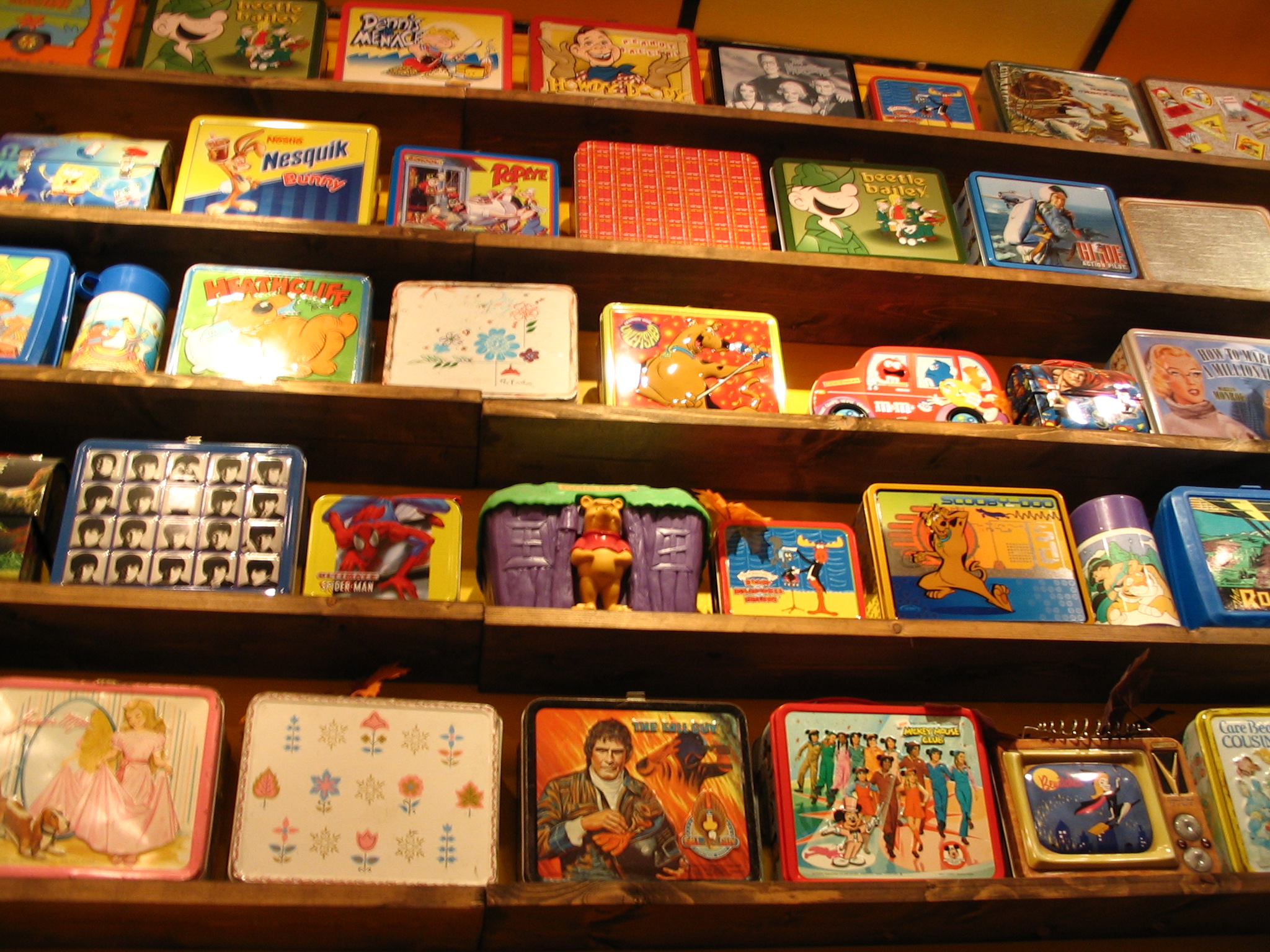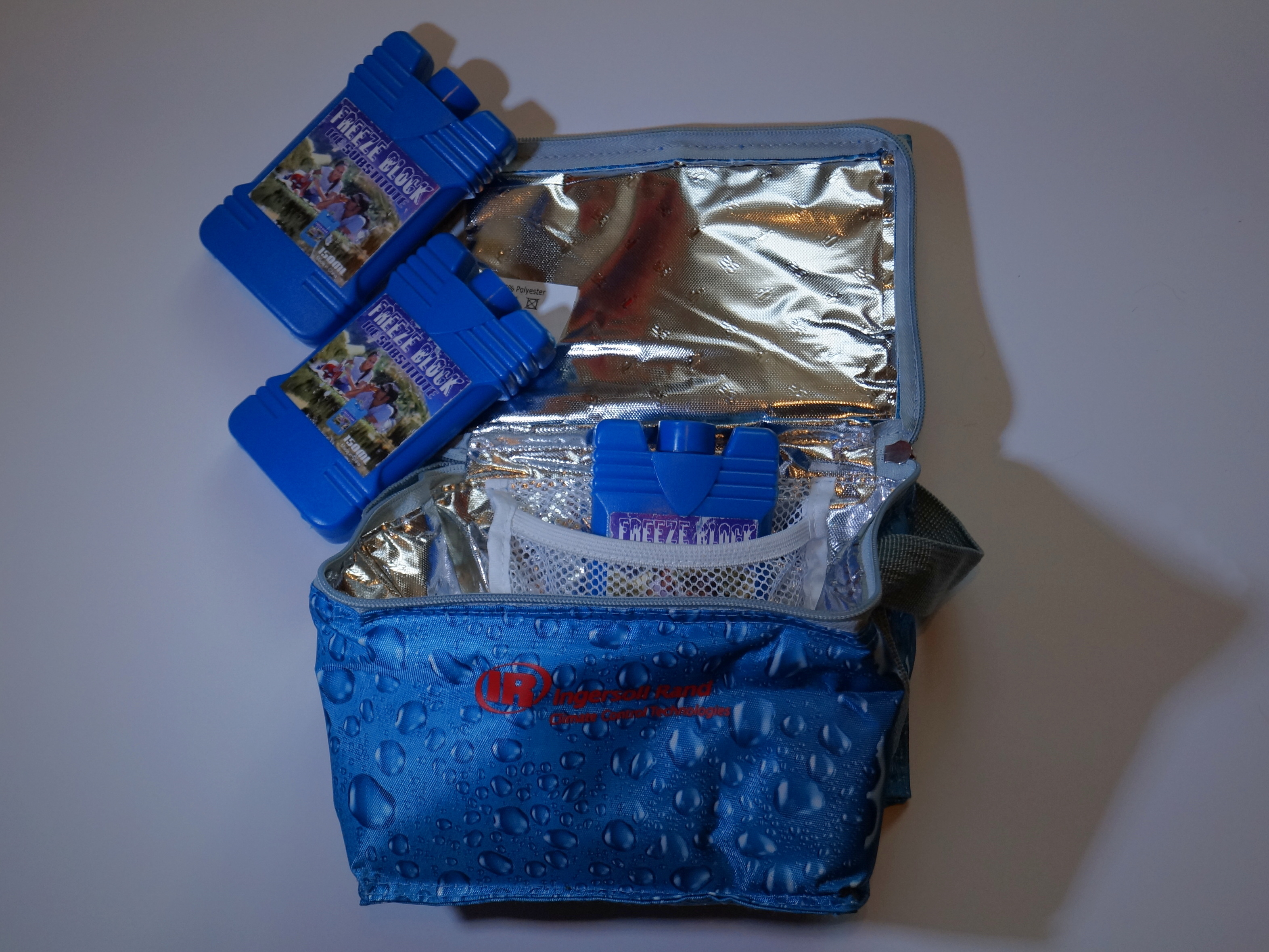lunch basket on:
[Wikipedia]
[Google]
[Amazon]

 A lunch box (alt. spelling lunchbox) refers to a hand-held container used to transport food, usually to work or to school. It is commonly made of metal or plastic, is reasonably airtight and often has a handle for carrying.
A lunch box (alt. spelling lunchbox) refers to a hand-held container used to transport food, usually to work or to school. It is commonly made of metal or plastic, is reasonably airtight and often has a handle for carrying.
History of Lunchboxes
Retrieved June 4, 2013. {{DEFAULTSORT:Lunch Box Food storage containers Academic meals

In the United States
In the United States a lunchbox may also be termed a lunch pail, lunch bucket or lunch tin, either as single words or paired. The concept of a food container has existed for a long time, but it was not until people began using tobacco tins to carry meals in the early 20th century, followed by the use oflithographed
Lithography () is a planographic method of printing originally based on the immiscibility of oil and water. The printing is from a stone (lithographic limestone) or a metal plate with a smooth surface. It was invented in 1796 by the German a ...
images on metal, that the containers became a staple of youth, and a marketable product. It has most often been used by schoolchildren to take packed lunches, or a snack, from home to school. The most common modern form is a small case with a clasp and handle, often printed with a colorful image that can either be generic or based on children's television shows or films. Use of lithographed metal to produce lunch boxes in the 1950s, 1960s, 1970s and 1980s gave way in the 1990s to use of injection-mold
Injection moulding (U.S. spelling: injection molding) is a manufacturing process for producing parts by injecting molten material into a mould, or mold. Injection moulding can be performed with a host of materials mainly including metals (for ...
ed plastic.
A lunch kit comprises the actual "box" and a matching vacuum bottle. However, popular culture has more often embraced the singular term lunch box, which is now most commonly used.
With increasing industrialization resulting in Americans working outside the home in factories, it became unfeasible to go home to lunch every day, thus it was necessary to have something to protect and transport a meal. Since the 19th century, American industrial workers have used sturdy containers to hold hardy lunches, consisting of foods such as hard-boiled eggs, vegetables, meat, coffee, and pie. David Shayt, curator of the Smithsonian National Museum of American History, states that "Some of our earliest examples, from the 19th century, were woven baskets with handles. A meal would be wrapped in a handkerchief. Depending on your station, a fancy wooden box would be used by the wealthy." Tinplate boxes and recycled biscuit tins commonly were used in the early 1800s, and fitted metal pails and boxes began to appear around the 1850s. Patents started to appear for lunchbox inventions in the 1860s.
The Thermos, a vacuum flask adapted for lunch box use, was introduced in 1904. The Thermos, which enabled hot or cold beverages to remain at optimal temperature until lunchtime, became a common component of the lunch box. The American Thermos Bottle Co. of Norwich, CT, later named King Seeley Thermos or KST, "produced the first metal lunch box for kids in 1920" as a "vehicle for their vacuum bottles."
Decorated
The first lunch box decorated with a famouslicensed character
Licensing means renting or leasing of an intangible asset. It is a process of creating and managing contracts between the owner of a brand and a company or individual who wants to use the brand in association with a product, for an agreed period ...
was introduced in 1935. Produced by Geuder, Paeschke & Frey, it featured Mickey Mouse
Mickey Mouse is an animated cartoon Character (arts), character co-created in 1928 by Walt Disney and Ub Iwerks. The longtime mascot of The Walt Disney Company, Mickey is an Anthropomorphism, anthropomorphic mouse who typically wears red sho ...
, and was a four-color lithographed oval tin, with a pull-out tray inside. It had no vacuum bottle, but did have a handle.
In 1950, Aladdin Industries created the first children's lunch box based on a television show, ''Hopalong Cassidy
Hopalong Cassidy is a fictional cowboy hero created in 1904 by the author Clarence E. Mulford, who wrote a series of short stories and novels based on the character. Mulford portrayed the character as rude, dangerous, and rough-talking. He was ...
''. The Hopalong Cassidy lunch kit, or "Hoppy", quickly became Aladdin's cash cow. Debuting in time for back-to-school 1950, it would go on to sell 600,000 units in its first year alone, each at 2.39. In 1953, Roy Rogers and Dale Evans were featured on models introduced by American Thermos.
Over 450 decorated models quickly followed, and more than 120 million metal lunch boxes were sold between 1950 and 1970, often accompanied by a Thermos, initially made of metal and glass, and later plastic.
Lunch boxes have been manufactured using various materials. Typically, children's school lunch boxes are made of plastic or vinyl, while adult workers' lunch boxes are commonly made of metal, such as tin or aluminium, due to the greater need for durability. The aluminium variant was invented in 1954 by Leo May, a miner
A miner is a person who extracts ore, coal, chalk, clay, or other minerals from the earth through mining. There are two senses in which the term is used. In its narrowest sense, a miner is someone who works at the rock face; cutting, blasting, ...
in Sudbury Sudbury may refer to:
Places Australia
* Sudbury Reef, Queensland
Canada
* Greater Sudbury, Ontario (official name; the city continues to be known simply as Sudbury for most purposes)
** Sudbury (electoral district), one of the city's federal e ...
, Ontario, after he accidentally crushed his tin lunch box.
Manufacturers grew to include ADCO Liberty, Kruger Manufacturing Company, Landers, Frary and Clark (Universal), Okay Industries, and a number of other producers through the 1980s.
The first use of plastics was the lunch box handle, but later spread to the entire box, with the first molded plastic boxes produced during the 1960s. Vinyl lunch boxes debuted in 1959.
During the 1960s, the lunch box had few changes. The vacuum bottle included in them, however, steadily evolved during the course of the decade and into the 1970s. What was originally a steel vacuum bottle with glass liner, cork or rubber stopper, and bakelite
Polyoxybenzylmethylenglycolanhydride, better known as Bakelite ( ), is a thermosetting phenol formaldehyde resin, formed from a condensation reaction of phenol with formaldehyde. The first plastic made from synthetic components, it was developed ...
cup became an all- plastic bottle, with insulated foam rather than vacuum. Aladdin produced glass liners into the 1970s, but they were soon replaced with plastic.
School safety
Beginning in Florida during the 1970s, with the lobbying of parents who claimed the metal boxes were being used as weapons in fights, many schools in the United States banned metal lunch boxes. One of the last metal lunchboxes to be widely produced was one with a design promoting '' Rambo: First Blood Part II''.Health issues
Health concerns came to light in August 2002, when the Center for Environmental Health discovered that many popular vinyl lunch boxes contained dangerously high levels of lead. Many, though not all, were pulled from the shelves. In 2001, most major manufacturers began testing their lunch boxes for lead levels, remedied the issue, and labeled their boxes as lead free.Today
Today, lunch boxes are generally made of plastic, withfoam insulation
Building insulation materials are the building materials which form the thermal envelope of a building or otherwise reduce heat transfer.
Insulation may be categorized by its composition (natural or synthetic materials), form (batts, blankets, lo ...
, and an aluminium/ vinyl interior. As a result, they are usually much better at retaining their temperature but are less rigid/protective. However, metal lunch boxes are still produced, just not as popular as they were in the 1960 through 1980's.
Collecting
Some lunch boxes, including those from the 1950s and 1960s, sometimes sell into the thousands of dollars. In 1999, a "1954 Superman lunch box, made by Adco Liberty" was "gaveled down for $11,500" ("the highest auction price ever paid for a lunch box").In popular culture
* ASuperman
Superman is a superhero who appears in American comic books published by DC Comics. The character was created by writer Jerry Siegel and artist Joe Shuster, and debuted in the comic book ''Action Comics'' #1 (cover-dated June 1938 and publi ...
DVD set was released in a case resembling a tin lunch box, albeit notably smaller.
* A Nintendo DS
The is a handheld game console produced by Nintendo, released globally across 2004 and 2005. The DS, an initialism for "Developers' System" or "Dual Screen", introduced distinctive new features to handheld games: two LCD screens working in tan ...
starter kit was released in a case resembling a tin lunch box with ''New Super Mario Bros.
is a platform video game developed and published by Nintendo for the Nintendo DS. It was first released in May 2006 in North America and Japan, and in PAL regions on June 2006. It is the first installment in the '' New Super Mario Bros.'' sub ...
'' graphics.
* The collector's edition of '' Fallout 3'' was made available in a metal Vault-Tec lunch box, the likes of which can be found throughout the game world itself.
* ''The Lunchbox'' movie.
Political symbolism
In the United States, the lunch box or lunch pail has been used as a symbol of the working class. The phrase "lunch pail Democrat In United States politics, the term lunch pail Democrat, lunchbox Democrat, or lunchbucket Democrat refers to members of the Democratic Party of a "blue collar" or working-class background, as well as politicians who share or attempt to leverage thi ...
" is used to classify populist politicians who attempt to gain the votes of the working class. ''The New York Times'' printed in 2008 that
Joe Biden is a lunch-bucket Democrat. While his father had been wealthy early in life, by the time Biden was born, the family was broke.
Outside the United States
Japan has a tradition of '' bento'', individual portable meals, that dates back several centuries and influenced other countries in South East Asia. Bento generally consists of rice and a number of other food items, transported within a lunchbox that has compartments to keep each item separate. In Mumbai, India, there are extensive lunchbox delivery services, continuing a business model that originated in 1890, where delivery staff called ''dabawalla
The dabbawalas (also spelled dabbawallas or dabbawallahs, called tiffin wallahs in older sources) constitute a lunchbox delivery and return system that delivers hot lunches from homes and restaurants to people at work in India, especially in Mu ...
s'' pick up metal tiffin carrier lunchboxes containing freshly cooked food, usually from the recipient's home, deliver them to people at their place of work and return empty lunchboxes.
In some South American countries, a lunch box is called " lonchera", especially among school children, in assimilation of the English word "lunch".
See also
* '' Bento'' – Japan * '' Dosirak'' – Korea * Tiffin carrier – India * Brown bagReferences
External links
History of Lunchboxes
Retrieved June 4, 2013. {{DEFAULTSORT:Lunch Box Food storage containers Academic meals
Box
A box (plural: boxes) is a container used for the storage or transportation of its contents. Most boxes have flat, parallel, rectangular sides. Boxes can be very small (like a matchbox) or very large (like a shipping box for furniture), and can ...